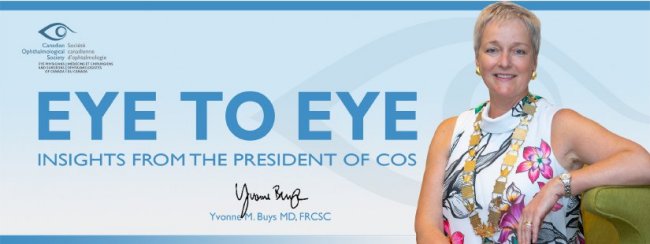
VERSION FRANÇAISE
 FALL 2018Dear Colleagues, It is my pleasure to address you as your new President and to articulate my vision for COS during my tenure, and also to share a little bit about me. I have spent much of my professional life involved with COS and have worn a number of hats; serving as Chair of the COS Annual Meeting from 2013-2018, COS Treasurer from 2010-2013, and Section Editor for Glaucoma for the Editorial Board of the Canadian Journal of Ophthalmology (CJO) from 2009-2015. Through these various roles, I have met COS members from across the country, many of our international colleagues and key opinion leaders, and have developed a deeper understanding of the opportunities and challenges facing our profession. COS exists because of and for its members, and retaining and attracting members is fundamental to our ability to be the voice of ophthalmology in Canada. Across the country, the proportion of ophthalmologists who are COS members varies considerably, with the lowest representation in Quebec. While we have made gains in our membership numbers, I would like to see COS aim for about 85% representation nationally. But as membership is always driven by perceived value, we have to continually demonstrate our relevance, particularly in the areas of advocacy and continuing professional development (CPD). On the advocacy front, COS has made significant investments in this area, and under the leadership of Dr. Phil Hooper, Chair, Council on Advocacy, we have undertaken unprecedented consultations with our provincial associations. While our healthcare system is largely managed at the provincial level, many of the issues facing ophthalmology in individual provinces (from fee code negotiations to expanded scope of practice for allied health professionals) are in fact occurring (or about to occur) in other provinces. COS plays a vital role in providing a national view of key issues and a forum for the provinces and the subspecialty societies to learn from each other. Advocacy initiatives, government relations and effective media and communications (such as our See The Possibilities campaign) take time, are expensive and require experienced staff with expertise in these areas. Many COS members recognize the critical importance of COS's advocacy role, as evidenced by the response to the Society's appeal for a voluntary contribution of at least $700 to fund ongoing efforts. To date, we have achieved 92% of our financial target for the Advocacy and Public Awareness Fund. In addition to financial support, we rely on volunteer contributions of our members for the success of these initiatives. In terms of CPD, the Annual Meeting continues to be our flagship event. Over the past eight years, it has grown significantly and now competes with international meetings in terms of the level of education provided, diversity of learning formats and opportunities to connect with colleagues from across Canada and the globe. I am confident the meeting will continue to expand and attract world-class faculty with our new Annual Meeting Chair, Dr. Mona Harissi-Dagher, at the helm. In addition, members can look forward to increased CPD offerings being developed and accredited under the leadership of Dr. Colin Mann, Chair, Council on CPD and of the Maintenance of Certification (MOC) committee. In the months ahead, COS members will notice investments in these key areas of membership, advocacy and CPD. A new Practice Resource Centre will be launched, providing members with access to an online hub of tools and resources related to the ophthalmologist's practice, including CPD opportunities and events, accredited and unaccredited activities, position statements, and much more. To facilitate this and other initiatives the COS website will be overhauled. We will continue through Year 3 of the See The Possibilities campaign to raise awareness of the skill and innovation of ophthalmology with the media, government, the public and other healthcare providers as a way to position ophthalmologists as the medical and surgical leaders of the eye and vision care team. COS has developed a number of resources and tools to support advocacy such as an Advocacy Toolkit, providing advocacy training, access to a Measured Response Process, and ongoing media and communications support as it relates to advocating for the profession. Stay tuned for more on these exciting initiatives! I urge all COS members to encourage your colleagues to join COS and to participate in our efforts to ensure ophthalmologists have a strong voice. As the saying goes, "If you're not at the table, you're on the menu!" We need to keep all channels of communication open - with our subspecialty societies and provincial associations, the academic community, optometrists and governments. By all playing to our strengths, we can work together to ensure the best for our patients.
Yvonne M. Buys MD, FRCSC |
